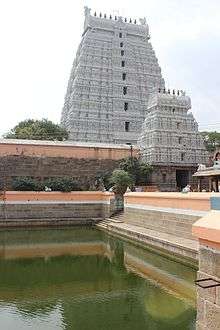Gopuram
Gopuram is a monumental tower, usually ornate, at the entrance of any temple, especially in Tamil Nadu, Andhra Pradesh, Kerala, Karnataka states of Southern India. This forms a prominent feature of Hindu temples of the Dravidian style.[1] They are topped by the kalasam, a bulbous stone finial. They function as gateways through the walls that surround the temple complex.[2]
The gopuram's origins can be traced back to early structures of the Pallava kings; and by the twelfth century, under the Pandya rulers, these gateways became a dominant feature of a temple's outer appearance, eventually overshadowing the inner sanctuary which became obscured from view by the gopuram's colossal size.[3] It also dominated the inner sanctum in amount of ornamentation. Often a shrine has more than one gopuram.[4] They also appear in architecture outside India, especially Khmer architecture, as at Angkor Wat.
A koil may have multiple gopurams, typically constructed into multiple walls in tiers around the main shrine. The temple's walls are typically square with the outer most wall having gopuras. The inner sanctum and its towering roof (the central deity's shrine) is also called the Vimanam (shrine).
Etymology

The Tamil derivation is from the two words: கோ (kō) and புறம் (puram) meaning 'king' and 'exterior' respectively.[5] It originates from the Sangam age when it was known as ஓங்கு நிலை வாயில் (ōnggu nilai vāyil) meaning 'imperishable gateway'.[6]
Architecture

A gopuram is usually rectangular in form with ground-level wooden doors, often richly decorated, providing access. Above is the tapering gopuram, divided into many storeys which diminish in size as the gopuram tower narrows. Usually the tower is topped with a barrel vaulted roof with a finial.[3] The form began rather modestly in the 10th century, as at Shore Temple, Mamallapuram, with the 11th century Brihadeeswarar Temple in Thanjavur marking a crucial step forward with two multi-storey gopurams from that period, much larger than any earlier ones, though much smaller than the main tower (vimanam) of the temple. The four gopurams of the Thillai Natarajar Temple, Chidambaram are important early examples, begun in the mid-13th century but completed over a longer period.[7] Gopurams are exquisitely decorated with sculpture and carvings and painted with a variety of themes derived from the Hindu mythology, particularly those associated with the presiding deity of the temple where the gopuram is located. Sri Ranganathaswamy Temple in Srirangam, Tamil Nadu is the tallest Gopuram in the world.
See also
Notes
- ↑ Ching, Francis D.K.; et al. (2007). A Global History of Architecture. New York: John Wiley and Sons. p. 762. ISBN 0-471-26892-5.
- ↑ Ching, Francis D.K. (1995). A Visual Dictionary of Architecture. New York: John Wiley and Sons. p. 253. ISBN 0-471-28451-3.
- 1 2 Mitchell, George (1988). The Hindu Temple. Chicago: University of Chicago Press. pp. 151–153. ISBN 0-226-53230-5.
- ↑ "gopura". Encyclopædia Britannica. Retrieved 2008-01-20.
- ↑ Sellby, Martha A.; Indira Viswanathan Peterson (2008). Tamil geographies: cultural constructions of space and place in South India. SUNY Press.
- ↑ S. Sundararajan (1991). Ancient Tamil country: its social and economic structure. Navrang.
- ↑ Harle, 320-325
References
Dallapiccola, Anna L. (2002). Dictionary of Hindu Lore and Legend. London: Thames & Hudson. ISBN 0-500-51088-1.
- Harle, J.C., The Art and Architecture of the Indian Subcontinent, 2nd edn. 1994, Yale University Press Pelican History of Art, ISBN 0300062176
External links
| Look up gopuram in Wiktionary, the free dictionary. |
| Wikimedia Commons has media related to Gopurams. |


.jpg)




.jpg)











